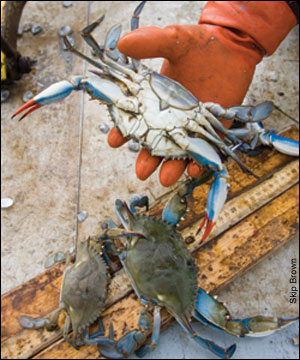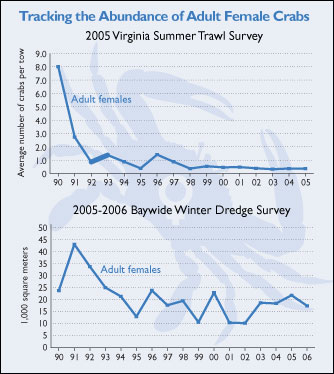
|
By Jack Greer
Rom Lipcius is worried. He's been watching crabs for more than a decade, mostly looking for females. Now this fisheries ecologist from the Virginia Institute of Marine Science (VIMS) is worried because he isn't finding them.
At least not in the numbers he's hoping for. Of all the information gathered on the blue crab in the past twenty years, the data collected by Lipcius and his colleagues is almost certainly the most disturbing.
Every summer since 1988, from July through September, VIMS has towed a trawl net — 45 times each month — through the Bay's mainstem spawning area. This large swath of the southern Bay, which stretches from the Rappahannock River down to the Bay mouth, is where most Bay crabs spawn. For nearly a decade now, Lipcius and his colleagues have pulled up an average of less than one female crab per tow.
Some might argue that they just don't know how to catch crabs. Not so. In 1990 the team netted eight female crabs per tow. In 1991 they averaged nearly three. But by 1996 just slightly more than one.
From eight to three to two to less than one female crab per tow. That's a precipitous drop, but the bad news doesn't stop there. The worse news is that since 1998 the number hasn't risen. Year after year, the numbers have been in the basement, and that's why Lipcius is worried.
How worried, say on a scale of 1 to 10?
"Around an 8. The blue crab has lost its buffer," Lipcius says. This is worrisome, he feels, because there are threats that could take the stock even lower: shoreline development that destroys nursery areas; a loss of prey, such as clams, that crabs feed on; a change in food webs, including more competition from cow-nosed rays; a loss of seagrasses; and climate change.
And on top of all this is what Lipcius calls "depensatory fishing," the tendency to fish a stock harder as it declines. Since crabbers will try to take home the same catch, no matter how many crabs are out there, the lower the stock, he says, the higher the percentage taken by crabbers.
These low numbers of female spawners puzzle many in the crab research community. While harvests are below the period average of 1990-2005, they have not crashed. And the winter dredge survey, now the gold standard for counting crabs in the Bay, shows adult female abundance holding fairly steady since about 1994.
Why the discrepancy?
First, according to researchers like Tom Miller at the University of Maryland Center for Environmental Science, harvests can stay at least somewhat constant in the face of stock declines, because crabbers will simply work harder to catch a similar amount of crabs.
Second, female blue crabs are prodigious spawners. They can produce as many as 8 million eggs or so per female, and even though they mate only once, they store the inseminating fluid and can spawn several times. That's a lot of eggs, even from a relatively small confederacy of females. Since we have not witnessed a collapse of the stock, Lipcius explains, there are evidently enough eggs to keep the population going.
For now.
The worry, according to researchers like Lipcius and Miller, is that there is bound to be a threshold somewhere, a tipping point beyond which a loss of spawning females will mean a loss of adequate egg production. We just don't know where we will hit that threshold.
If do we approach that tipping point, will there be any warning? No, says Lipcius, and Miller agrees. It's likely that stocks would continue at a steady level until female crab abundance dropped below a certain point. The only warning would probably be numbers of years of low female crab abundance — precisely the kind of data the VIMS trawl survey has turned up since the early 1990s.
|
|

Down and staying down has been the story for female crabs in the lower Bay, according to the summer trawl survey undertaken by the Virginia Institute of Marine Science each year (upper graph). The picture does not look quite so grim in data from the winter dredge survey (lower graph), but the two graphs may each have a story to tell. According to some experts, it may be that female crabs are just not making it down to the spawning grounds because of high fishing pressure. Other concerns, such as loss of habitat and shifting food webs may also play a part. Whatever the reason, these low survey numbers are worrisome for the Bay blue crab despite a recent lessening of fishing pressure. Graphs reprinted, with permission, from Blue Crab 2005 Status Report, Bi-State Blue Crab Technical Advisory Committee, Chesapeake Bay Commission. |
According to Lipcius, an environmental factor, such as dying seagrasses or the degradation of nursery areas by development, could push the blue crab over the edge. If this does happen, there will not likely be a quick rebound, he says, because all these factors — climate, habitat, fishing — would operate to keep crab numbers down.
In fact, he says, we may already be seeing what he calls an equilibrium shift, a slide toward a new, lower level for blue crabs that may be difficult to bring back.
What should be done? For one thing, Lipcius says, we should do more to protect spawning females. The Blue Crab Subcommittee of the Virginia Marine Resources Commission has made a formal recommendation to do just that. The subcommittee, on which Lipcius serves, wants to extend the spawning sanctuary for blue crabs from its current limit at the Bay mouth clear down to the North Carolina border. This is because surveys have found large numbers of egg-bearing females (called sponge crabs) close along the Atlantic shore. During the summer the seashore is evidently a hotbed for spawning blue crabs.
Lipcius says that the subcommittee is also recommending a new review of Virginia's crab regulations, to make sure that they are all working in concert to protect the spawning stock. Lipcius, who was instrumental in establishing the summer spawning sanctuary in the Virginia portion of the mainstem Bay, leaves us with a word of caution. The sanctuary, he says, will only protect female crabs if we let them live long enough to make it that far.
![[Maryland Sea Grant]](/GIFs/h_footer_mdsg.gif)